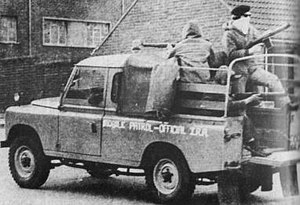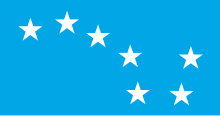
Back IRA Oficial Catalan Oficiální irská republikánská armáda Czech Official Irish Republican Army German Ejército Republicano Irlandés Oficial Spanish Irlandako Armada Errepublikazalea - Ofiziala Basque Official Irish Republican Army French IRA Oifigiúil Irish Official IRA Italian 아일랜드 공화국군 공식파 Korean Official Irish Republican Army Dutch
| Official Irish Republican Army (Óglaigh na hÉireann) | |
|---|---|
 Official IRA patrol vehicle in Turf Lodge, Belfast, April 1972 | |
| Leaders | Cathal Goulding, Billy McMillen |
| Dates of operation | December 1969 – Late 1990s (on ceasefire since 1972) |
| Split from | Anti-Treaty Irish Republican Army |
| Headquarters | Dublin |
| Active regions | Northern Ireland (mainly); Republic of Ireland; England |
| Ideology | |
| Political position | Far-left |
| Size | 1,500–2,000 (between 1969 and 1972) |
| Allies | |
| Opponents | Provisional IRA Irish National Liberation Army |
| Flag |  |
| Part of a series on |
| Irish republicanism |
|---|
 |
The Official Irish Republican Army or Official IRA (OIRA; Irish: Óglaigh na hÉireann) was an Irish republican paramilitary group whose goal was to remove Northern Ireland from the United Kingdom and create a "workers' republic" encompassing all of Ireland.[2] It emerged in December 1969, shortly after the beginning of the Troubles, when the Irish Republican Army (IRA) split into two factions. The other was the Provisional IRA. Each continued to call itself simply "the IRA" and rejected the other's legitimacy.
Unlike the "Provisionals", the "Officials" did not think that Ireland could be unified until the Protestant majority and Catholic minority of Northern Ireland were at peace. The Officials were Marxist-Leninists and worked to form a united front with other Irish communist groups, named the Irish National Liberation Front (NLF).[3] The Officials were called the NLF by the Provisionals[4][5] and "stickies" by nationalists in Belfast (apparently in reference to members who would glue Easter lilies to their uniforms),[6] and they were sometimes nicknamed the "Red IRA" by others.[7][8][9]
It waged a limited campaign against the British Army, mainly involving shooting and bombing attacks on troops in urban working-class neighbourhoods. Most notably, it was involved in the 1970 Falls Curfew and carried out the 1972 Aldershot bombing. In May 1972, it declared a ceasefire and vowed to limit its actions to defence and retaliation.[10] By this time, the Provisional IRA had become the larger and more active faction. Following the ceasefire, the OIRA began to be referred to as "Group B" within the Official movement.[11][12] It became involved in feuds with the Provisional IRA and the Irish National Liberation Army (INLA),[13] an OIRA splinter group formed in 1974. It has also been involved in organized crime and vigilantism.
The Official IRA was linked to the political party Official Sinn Féin, later renamed Sinn Féin The Workers Party and then the Workers' Party.
- ^ "'Official' IRA hid 5,000 AK-47s in secret bunkers". Independent.ie.
- ^ Statement from Cathal Goulding, C/S of the Official IRA, in early 1972, quoted in On Our Knees by Rosita Sweetman, Pan Books, London. 1972. ISBN 0-330-23320-3. p. 146
- ^ Coogan, Tim Pat. The Troubles: Ireland's Ordeal and the Search for Peace. Palgrave Macmillan, 2002. p.113
- ^ Taylor, Peter. Behind the Mask: The IRA and Sinn Fein. TV Books, 1999. p.84
- ^ O'Ballance, Edgar. Terror in Ireland: The Heritage of Hate. Presidio Press, 1981. p.133
- ^ "On the streets of Belfast, they were often distinguished as the ‘Provos’ and the ‘Stickies’, because Officials would supposedly wear commemorative Easter lilies stuck onto their shirtfronts with adhesive, whereas the more dyed-in-the wool Provos wore paper lilies affixed with a pin." Chapter 4, Keefe, Patrick Redden "Say Nothing: A Tale of Murder and Mystery in Ireland", published 2018
- ^ Rekawek, Kacper. Irish Republican Terrorism and Politics: A Comparative Study of the Official and the Provisional IRA. Taylor & Francis, 2011. pp.1-2
- ^ "Obituaries: Seamus Twomey, 70, a Leader of Provisional I.R.A." Archived 19 December 2017 at the Wayback Machine. Reuters. The New York Times, 14 September 1989.
- ^ "IRA itself is divided on strategy, ideology". The Toledo Blade, 11 November 1971.
- ^ Holland, Jack (1994). INLA: Deadly Divisions. Dublin: Torc. pp. 17, 26, 39. ISBN 1-898142-05-X.
- ^ Sanders, Andrew. Inside the IRA: Dissident Republicans and the War for Legitimacy. Edinburgh University Press, 2011. p.191
- ^ Brian Hanley and Scott Millar, The Lost Revolution: The Story of the Official IRA and the Workers' Party. Penguin UK, 2009. Chapter 12: Group B.
- ^ Holland, Jack (1994). INLA: Deadly Divisions. Dublin: Torc. pp. 41–54. ISBN 1-898142-05-X.
© MMXXIII Rich X Search. We shall prevail. All rights reserved. Rich X Search